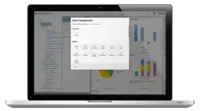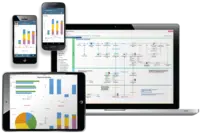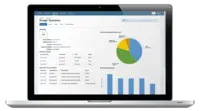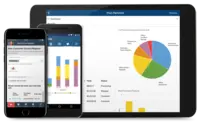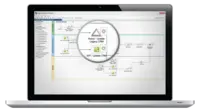Overview
What is Appian?
Appian is a low-code development and business process management platform. It features drag-and-drop design for app building, automated work processes, unified data management, and cloud-based deployment.
Great Low code - no code Workflow tool in the market!!
TrustRadius Insights
Appian Is The Best Low ode Plateform
Low-code Prog: The Best Way To Digitalize Your Life
Best in class BPM tool
Appian is one of the best Low Code platform
BEST BPM TOOL - APPIAN
Quickly deliver upon your ROI goals
Leading us into the future
Appian--reduce time and effort for employees
remote user
A+ for Appian
its helpful
very good workflow software
Awards
Products that are considered exceptional by their customers based on a variety of criteria win TrustRadius awards. Learn more about the types of TrustRadius awards to make the best purchase decision. More about TrustRadius Awards
Popular Features
- Platform Scalability (73)9.494%
- Reusability (75)9.494%
- Drag-and-drop Interfaces (72)8.989%
- Visual Modeling (73)8.888%
Reviewer Pros & Cons
Pricing
Appian Community Edition
$0
Application - Input-Only
$2
Application - Infrequent
$9
Entry-level set up fee?
- No setup fee
Offerings
- Free Trial
- Free/Freemium Version
- Premium Consulting/Integration Services
Product Demos
APPIAN DEMO RECORDING SESSION # 91-9866955524
Appian Developer Tutorial for Beginners | Appian Training
APPIAN DEMO
APPIAN DEMO | Harsha Trainings |
Features
Low-Code Development
Low-code development tools allow non developers to build simple process applications with little oversight. These tools simplify the application building process, and are frequently used for simple process applications.
- 8.8Visual Modeling(73) Ratings
Visual modeling tooling allows business users to design processes visually.
- 8.9Drag-and-drop Interfaces(72) Ratings
Drag-and-drop interface for building applications
- 9.1Platform Security(71) Ratings
Security guardrails in place to help prevent malware, data breaches etc.
- 8.8Platform User Management(72) Ratings
Tools enabling admins to control user access and on-board and off-board users
- 9.4Reusability(75) Ratings
An internal repository where assets, modules, and even entire applications can be reused
- 9.4Platform Scalability(73) Ratings
Apps developed by low-code platform must be scalable and capable of supporting large numbers of users
Product Details
- About
- Competitors
- Tech Details
- Downloadables
- FAQs
What is Appian?
Appian provides a software development platform that combines Full-Stack Automation and enterprise low-code to rapidly deliver business applications. Appian can be used to improve customer experience, achieve operational excellence, and simplify global risk and compliance.
Appian is a platform for building enterprise software applications. Appian boasts running some of the most important processes at companies like Enterprise Rent-A-Car, Aviva, Dallas/Fort Worth International Airport, and the US Department of the Treasury.
Some Appian use cases include - Intelligent Business Process Management Systems (iBPMS), Dynamic Case Management (DCM), Digital Process Automation (DPA), Robotics Process Automation (RPA), and Low-code Development.
Appian Features
Low-Code Development Features
- Supported: Visual Modeling
- Supported: Drag-and-drop Interfaces
- Supported: Platform Security
- Supported: Platform User Management
- Supported: Reusability
- Supported: Platform Scalability
Appian Screenshots
Appian Videos
Appian Competitors
- OutSystems
- Pega Platform
- Salesforce
Appian Technical Details
| Deployment Types | On-premise, Software as a Service (SaaS), Cloud, or Web-Based |
|---|---|
| Operating Systems | Windows, Linux |
| Mobile Application | Apple iOS, Android, Windows Phone, Blackberry, Mobile Web |
Appian Downloadables
- Enterprise Checklist: Pave The Path To Digital Prowess With Low-Code Platforms
- The BPM Guide: Accelerating Digital Transformation
- The Case Management Guide
- Appian Product Overview
- Appian Premier Support
- Deliver Customer Experience Excellence
- Appian for Employee Experience
- Appian Intelligent Contact Center™ Platform
- The Total Economic Impact™ Of Appian
- The 2021 Ultimate Low-Code Automation Buyer's Guide
Frequently Asked Questions
Comparisons
Compare with
Reviews and Ratings
(268)Community Insights
- Business Problems Solved
- Pros
- Cons
- Recommendations
Appian has proven to be a versatile and valuable tool for a wide range of use cases across various industries. Users and customers have reported success in automating business processes, improving productivity, and streamlining operations. Organizations have utilized Appian to replace manual paper-based systems, enabling online applications, document uploads, and simultaneous stakeholder reviews. This has greatly enhanced collaboration and cross-referencing of applications between different organizations.
In the healthcare sector, Appian has been instrumental in automating patient registration, diagnosis, and treatment workflows, eliminating paper-based processes and connecting patients with doctors and departments in a faster and more streamlined way. The platform has also been widely used for low code development and migrating older applications to the Appian code base. Additionally, Appian's capabilities in digital transformation and data analysis have allowed departments to study their own data and generate insightful reports.
Users have found Appian to be particularly beneficial for managing processes in areas such as trade reporting, client mailing process automation, onboarding new hires, workforce planning, case management, consumer marketing lists generation, CRM management, retail store remodeling, and even setting up cafes. They appreciate its ability to simplify complex tasks, automate mundane processes, and integrate with various systems. Furthermore, reviewers have commended Appian for its performance and scalability in handling large volumes of data and processes.
Overall, Appian's flexibility, customization options, user-friendly interface, collaboration features, advanced analytics capabilities, seamless integration with other systems, and overall capability for rapid development and deployment have made it a reliable choice for organizations looking to streamline operations and improve efficiency.
Intuitive User Interface: Users have consistently praised Appian for its visually uncluttered and intuitive user interface, with many stating that it allows for quick adoption by both internal and external users. The simplicity and user-friendly nature of the interface make it easy for business users with minimal training to navigate and perform tasks efficiently.
Low-Code Development Platform: Many reviewers appreciate the ease of use provided by Appian's low-code development platform. They find it beneficial that they can develop user interfaces without extensive coding knowledge, allowing for rapid application development and reduced reliance on traditional programming languages. This feature has made the development process more accessible and efficient.
Flexible Access Control: A significant number of users praise Appian for its flexibility in providing different levels of access to users based on their roles. This capability contributes to better data security and control within organizations, enhancing overall data management. Additionally, the ability to tailor processes for specific business needs and configure processes for new business users is seen as a major advantage, contributing to the software's adaptability.
Inflexible and Expensive License Model: Some users have found the license model of Appian to be inflexible and expensive, making it challenging for them to include end customer processes due to limitations in named user licenses or big bang packages.
Limited Exporting and Data Analysis Capabilities: Reviewers have mentioned limitations on exporting data to Excel, causing inconvenience for users who need to analyze large amounts of data. They have also encountered issues with the date-time stamp of exported data, leading to problems in data analysis.
Steep Learning Curve and Technical Limitations: Users have highlighted a learning curve associated with the different paradigms in Appian and experienced technical limitations when using certain browsers, particularly with date controls. Workarounds were needed to overcome these limitations.
The most common recommendations from users are:
-
Try Appian for quick application development with less resources. Users have found Appian to be a reliable platform for rapidly building applications without requiring excessive time or resources.
-
Create evaluation criteria and apply a defined score to each platform for an informed decision. Users suggest defining specific criteria to evaluate different platforms and assigning scores to objectively compare them. This approach helps in making an informed decision when selecting the most suitable platform.
-
Develop a small Proof of Concept (POC) to determine the requirements before deploying Appian. Users recommend starting with a small POC to understand the specific requirements and capabilities of Appian within the organization. This allows for a better understanding of how Appian can meet the organization's needs and ensures a successful deployment.
By following these recommendations, organizations can leverage the benefits of Appian and efficiently develop applications while making informed decisions about their technology choices.
Attribute Ratings
Reviews
(1-22 of 22)Best in class BPM tool
- Easy to Develop (Low Code)
- Intelligent Case Management
- Integration using API's to a variety of technology tools
- Graphs and Charts. I think it will be good to get some features of PowerBi
- Additional DB options (Currently using MariaDB)
- Better interface for Database explorer and query window
Appian--reduce time and effort for employees
- Drag-and-drop UX
- Apps developed by exporting objects in XML and ZIP format
- Low-code development platform
- Test for completeness is possible
- Appian framework reuse for ADA
- Layman language
- Some more utility should be available for performance testing
- Multiple ZIP file creation with one import matching trick
- Recommendation engines should be modified
Appian is very supportable
- Process Models - they error in the background and the user does not know and support can fix it at a later time without the user having an issue.
- Support - I have had a good experience with Appian support responding in a timely manner.
- It's a Platform as a Service so the database, code, and application are all available through the same portal.
- It would be good to be able to capture data as an expression from the process modeler rather than the 'Raw' format with square brackets.
- Version Control that supports branching.
- Ability to see the state of child interfaces in the designer.
Recommended for client account creation and management
- Fast prototyping
- Low-code
- Easy UI design
- Clear project element organization
- More visual representation with variable relationships
- More UI options for color style
- More accurate error handling
Appian: Best bet in the market for quick turnarounds!
- Migration from legacy systems
- Eliminating legacy approaches
- Automating business processes
- Customer onboarding reports
- Drag-and-drop interface for workflow development greatly speeds our apps' time to market.
- Using the advanced features of Appian, we are able to create working sites in a fraction of the time it would take to do so using traditional development.
- Quick to the market, a real emergency problem solver (e.g., COVID time related apps).
- Build once, deploy anywhere makes it easy to put an application in users' hands, regardless of form factor (desktop, mobile, etc.).
- I would like to see more flexibility in Appian's UI components.
- Appian's RPA capabilities are still growing. I would like to see more user-friendly management/creation of RPA processes.
- Debugging can be difficult, as error messages are not always detailed enough.
A developer's opinion.
- It's easy to get started with little development experience.
- Changes are immediately visible.
- The Appian Community website usually has quick responses to questions.
- Better configuration management.
- Better control over change management.
- Error messages contain more specific errors.
Great for speedy user interface implementation!
- Appian speeds up the development.
- Easier to build user interfaces.
- When application using Appian fails - Appian throws pretty detailed errors helping debugging.
- Search issues when type ahead and database search are used in the same field.
- Buttons implementation where user is require[d] to click on the button description - if clicks on the button outside that text - button will not work.
- Problems with using certain off-the-shelf performance tools like WebLoad or Neoload. That is because of different dynamic variables being used internally in Appian - which these tools are unable to correlate. We are still investigating using other tools like JMeter to overcome dynamic correlation problem for performance testing.
On the other hand, there are some limitations which require creating Java or Java script functions. At this point, we did not try to convert the larger projects currently developed in Java into Appian - this is where we foresee the Appian limitations.
The solution(s) implemented in Appian are deployed worldwide across all Aon Reinsurance offices.
- Low code platform.
- High availability and scalability.
- Streamline integrations with external APIs.
- Monitoring and error logging.
- Integration with third party source control tools.
- Better CI/CD capabilities.
- Debug capabilities.
- OCR capabilities.
Appian is great choice and a difference maker
- Easily integrate data over silos
- Brings together business and IT people alongside a clearcut model and languange
- Quick to the market, a real emergency problem solver
- Strong stability combined with excellent architecture
- Provides excellent customer services and insight
- License model is rigid and expensive
- Hard to include end customer processes due to named user licenses or big bang packages
Needs and pushes an agile approach. Needs internal people development in order to own the technology challenges.
- Making process models the core of the solutions you build, with AI, Bot and human interactions through low-code UX.
- Highly skilled professional services team.
- Low code data integration that provides a platform for unifying data across back-end systems.
- Ideal for building tailored case management solutions.
- No built-in support for integrating with messaging or event streaming systems.
- Limited ability to customize UX beyond the out of the box components.
- No true cloud auto-scaling (yet); relies on reserved VM instances.
- Great for internal applications where complete control of the UX is not needed and the rapid development cycle of low-code can really shine.
- Great for building tailored case management solutions where the underlying escalation process can be customized via the BPM editor.
- Not appropriate for external/customer facing web portals that are public and/or where per-user licensing is a concern.
- Avoid human errors
- Centralize information
- [Accessible] everywhere, via pc or mobile device.
- Need individual [Appian] license
Appian: An easy way to be closed to the business
- Easy way to develop.
- Good to manage data and generate reports.
- No high programming skills needed.
- Not enough report capabilities.
- Not easy to generate beautiful tools.
- Sometimes rigid.
- Easy to get non-technical people up to speed.
- Compare and deploy means that deployments are simplified and avoid error.
- Integration is generally easy.
- Debugging can be difficult as error messages are not always detailed enough.
- Support is hard to get for individual freelancers and small company business partners.
- The flexibility between desktop and mobile development can sometimes limit specific development toward one platform.
- Simple workflows with approval processes e.g. with e-mail notifications, etc.
- Simple page-able and searchable lists to display data.
- Simple data entry screens.
- Quick implementations.
- Proof of concepts, potentially a very powerful tool.
Not so suited:
- Complex workflows with complex business validation rules.
- Complex integrations or UIs.
- Ease of building modern uniformed and dynamic UI.
- Web services support.
- In-place testing.
- Ability to extend application with usage of custom plug-ins.
- Unstable and sometimes forgiving and/or implied behavior for various complex language constructs, especially involving collections processing.
- Inability to customize UI only for a specific platform (e.g. Desktop) given priority to the notion of the universal platform support (desktop, tablet, mobile).
- Run-time error descriptions are not really helpful in many circumstances.
- The low-code environment is not low-code at all if you need to build UI of relatively medium complexity.
TrustAppian
- It's easy to configure/customize.
- It provides a consistent workflow across multiple pages/functions.
- It's designer interface allows for quick troubleshooting.
- There are places that come out-of-the-box that we can't customize, especially the user profile which sometimes, depending on the country/region privacy requirements, we need to be able to modify.
- There are places where brute force or hard coding is necessary
Not appropriate: Huge, complex business processes that would involve multiple users across a single transaction.
Appian Review
- Organization of data into an easily, readable format.
- Providing different levels of access, depending on the role of the user.
- Being able to develop UIs without having to use code.
- I am a new user to Appian, and am not too familiar with the product just yet to find a weakness.
Appian Tool for scalabillity and RDBMS in application
- Manages database objects as CDTs which help in maintaining relational database
- Provides user-friendly interface for mapping
- Better explanation of various error emails which are received
How Appian made a difference
- Appian allows us to link systems together with data being automatically obtained from different areas of different databases. This has removed the requirement for the user to go to a screen and manually input data which then needs to be re-checked by a Supervisor.
- Appian enables us to react quickly to an ever changing regulatory environment.
- The re-useable components within Appian enable us to build and deploy new, straightforward, processes quickly.
- We haven't found the on-premise upgrade process straightforward. The versions seem to change fairly significantly and the installation guide isn't a good as it could be.
- Appian doesn't seem as resilient as other applications. For example, a VMware server recently had a failure and automatically failed over to a secondary. Every application running on the server recovered without intervention, but Appian didn't and was unavailable for around 2 hours whilst we worked with Appian support to diagnose and fix the issue.
- Lacking flexibility around proxy servers but this seems to have been resolved in version 17.3
We have found that operational users can 'programme' Appian for basic functionality using drag and drop but we have had to deploy a number of developers to work with the operational team for the vast majority of our process engineering re-development.
Appian has proved extremely valuable for the vast majority of the operational processes which we run removing checklists, layers of complexity and removing some manual entry.
We have linked Appian to our online systems which enables seamless straight through processing with Appian tasks automatically raised where manual intervention or review is required.
My experience with Appian.
- Responsive
- Instant results
- Interpretive
- Lack of version control and being different for all modules.
- Expression Language is a Lisp dialect - that forces functional programming. JavaScript or VB would be easier.
- Several users working on the same module might create problems. No individual work space.
- API is not well documented with comprehensive examples.
- Functions do not work well with large numbers when they should.
- Training exercises are full of mistakes - that turns training into the worst experience. Training MUST be improved to provide quality good examples, and not guesses what should be there but was missed. How can one learn - if training examples are a trash, while the exams ask questions on topics not covered????
- Too much documentation. Must be much, much more concise. Who can read and memorize so many pages of Appian "Britannica"???
- Some errors are captured during editing, while others are not, or show up in a different window????
- GUI widgets lack numerous hooks to make design more creative. Need access to all widget features. Otherwise developers are limited to "limited" widget behavior.
- Response in a cloud could be too slow, following data entry. For example, one enters a name and validation takes up to a dozen of seconds.
- Development environment is not coherent between different objects, some can only be edited using old GUI. A lot remains to be done to make development environment simple , intuitive and coherent.
Appian First Impressions
The type of use is the traditional BPM and also case management.
- Case Management. We like how Appian manages the data through Records. In our view of what a Case Management system should have, Appian is the most complete product we know, only the lack of a State Engine prevents us from giving it the highest score.
- Appian has all functionality included in only one product without additional installations. This include collaboration tools, reports, document management, integration connectors, etc.
- Document Management, Collaboration tools and integration capabilities, always are welcome to simplify the projects. Appian include all of this without additional cost.
- A state engine that can help manage the life cycle of the Cases, which can be changed from the process flows and from the outside.
- We have had some problems with the searches in the document manager, that is something that they have to improve.
- We do not like the management of WSDL documents, which have to be available on a Web server instead of a folder on the server, for example, and to change the endpoints have to edit the WSDL document.
Contracts Mangement using Appian Tempo (Social Media)
- Tempo was the key to providing flexibility and visibility to a varied and complex review and approval process while at the same time enforcing fundamental rules.
- The configurability of Appian allowed us to rapidly prototype application processes and re-adjust and re-assemble as required in sprints. I estimate there was less than 8 hours of actual coding involved in building it out.
- Business rules formulas, and constants can be very powerful in producing all the requirements of a process. If you can competently write an Excel macro you can learn Appian configuration.
- Training. While configuration is accessible, being really effective requires either a lot of hands on trial and error and/or the supervision and guidance of an experienced user. Appian training is a forced march overview and not at all effective in getting a user up to speed.
- Documentation. The online documentation, in the end, seems to be get lucky in finding what you are looking for or asking for help and waiting for an answer that may or may not be responsive. What may work well for their professional service people becomes problematic if you don't have a good understanding of the product in the first place.
- Sales. it's an impressive product and that makes it easy for anxious salespeople to oversell capabilities to executives who may not be in a position to be critical about promises and implications. This can lead to unfulfilled expectations that limit additional applications.
If the process is strictly a pipeline with little human touch and expected to remain essentially intact for a long period, there are probably other traditional products that would be more effective,
Appian - A software developer's friend
- I took the Appian training in Reston, VA and was impressed by the flexibility of the product. I am a software developer and found their JavaScript tools to be helpful and useful to customize and manipulate the various forms. It helped me leverage the out of the box product and add what I wanted to add without having to wait for them to develop a node that I needed to use.
- There is a user community from which you can get help on almost any question or problem you may encounter. This helps when you have something you want to do and don't have the expertise yet to accomplish it. There are many who have come before you that probably know at least one if not 5 different ways to accomplish what you want to do.
- The documentation of a workflow process uses standard BPMN language. It makes this more universal to have a process be created using third party tools and have it represent the workflow correctly in Appian.
- I mainly had to get used to the different paradigms that the software has. They are constantly making changes to improve the software so I didn't encounter things that were so hard to work with that I couldn't figure out a work around.
- At the time I was using the tool, I encountered some technical limitations when using certain browsers. Some browsers don't support the date controls so I had to do some work arounds. The revision control isn't too bad but it does create a lot of revisions that you may have to sort through in order to find what you were looking for if you wanted to revert to a previous revision.
- We used a Cloud implementation rather than hosting it locally. There are limitations when you do that in that it is harder to access local databases but I was able to eventually get access to local data but I had to do some custom programming outside of Appian to get that to happen.


